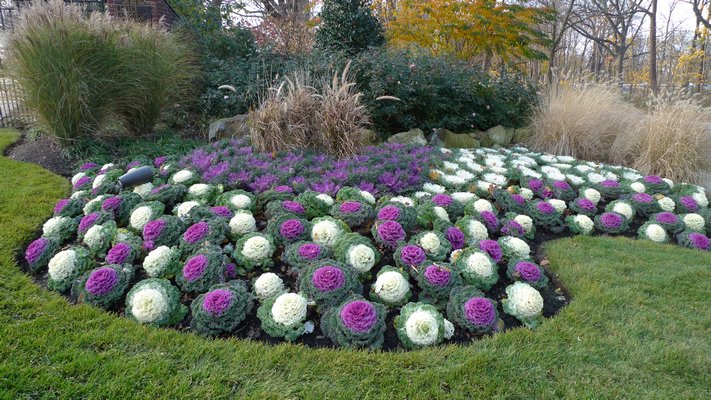

It's finally warm(ing), and every gardener's fancy is turning to planting.The garden centers are quickly filling up, and you can find potted perennials, trees and shrubs galore. UPS, FedEx and even the mailman are dropping off boxes and bags of bare-root and potted plants on a regular basis, and those who know what they're doing are out with a spade dividing and moving plants with near abandon.
But do you really know how to plant that 5-gallon pot of rhododendron? Do you know what steps to follow to get that 10-gallon apple tree set up for life? And that Rudbeckia triloba that came in a plastic bag with a dusting of peat moss … what in the world do you do with that?
Thankfully, just about everything comes with instructions and if it doesn't you can probably find them online. But one of the handiest things to have around this time of the year is one of those wonderful gardening encyclopedias that tells you how to do nearly everything. The problem, though, is that what we once thought was the right way to plant is turning out to be wrong, and many of those potted trees and shrubs you'll buy at the garden centers have built-in risks and issues.
So, what's a gardener to do? Ah, I'm so glad you asked, please read on.
There was once a time when there were only two ways to buy plants. The first was by going to a nursery, where the perennials were field-dug, wrapped with newspaper and sold in clumps. Trees and shrubs, on the other hand, were dug at the nursery and sold as balled and burlapped root balls (B&B), and some still are.
But with the switch to plastics, most of the plants we buy these days spend most of their days in black plastic pots. It makes the growing end of the business somewhat easier and allows for mass production, keeping prices down, but those plastic pots and the manner in which the plants in them are grown create problems that we often never find out about … until the plant dies two or three years later, you yank it out of the ground and the problem becomes sadly obvious.
My dead magnolia Spring Peppermint" is a wonderful example of this phenomenon. I saw a picture of this tree in a catalog in 2011. I was smitten by the flowers, imagined the wonderful scent and I had just the spot for it about 10 feet off my front porch between the hosta bed and the driveway. There's no way I'd find or be able to afford this tree if it were grown at a nursery, and no way I could get a mature specimen planted. So, like many of us, I bought it from a mail order nursery out in Wisconsin that had a stellar reputation. I paid about $35 for the tree and it arrived in April 2012 in a 2.5-quart pot. It was budded, had lots of leaves and was a size that I could easily dig a hole for and plant.
When the planting day came, I watered the tree in the pot until the water ran out of the holes at the bottom. I waited a few minutes and repeated. I then turned the tree upside down, used one hand at the base of the inverted tree with the trunk fitting in the V between my index and middle finger, and with the other hand I pulled the pot upward. It easily slid off and none of the soil fell away. That in itself was a clue that the root mass had encircled the soil and the pot to the point where nearly all the soil was compressed by the roots. We refer to this as being root-bound. That's OK in the nursery, but it's the worst thing possible when you're trying to get a plant to grow in your garden or landscape.
There are two options at this point. If you're patient and talented you can tease out the roots, loosen the soil, do a little root pruning in just the right spots, and then do the planting. If you're without the root-pruning talent then you're left to simply tease out the roots and loosen the root ball, then plant. But what I've learned since is that you have to be a little merciless in the root-teasing process.
What I mean by root teasing is finding the strongest and thickest roots and their ends and pulling these roots out of their circular obsession. For years they've been growing round and round in that plastic pot and that's all they know how to do and that's all they'll continue to do unless you intervene. Plant that tree, shrub or perennial as is and you'll have nothing but trouble. On the other hand, if you pull, tug and be relentless but not cruel you'll be rewarded. It hurts you more than the roots.
Left unmitigated and planted right out of the pot, the roots will continue to grow round and round and round, and will not venture out into the surrounding soil in the hole you've dug no matter how good that soil is and no matter how fantastic your homemade compost is. They will circle and circle and in a few years they will strangle each other and your tree will die or at best languish for several years in that hole. Then die.
But I digress. Back to my magnolia. I teased the roots a little, loosened the soil a little, planted my 3-foot tree in an ample hole with wonderful soil, not too high, not too low, a bit of organic root stimulant added to the first watering, and we were on our way. I put a little fence around it to protect my small investment from rabbits, deer and my tractor. I watered diligently through the hot summer and into the fall until the ground froze. The following spring, of 2013, the magnolia bloomed its young head off and during the summer it stretched sideways and skyways. It went into the winter of 2013-14 fully budded and come late April I waited for those buds to open. And I waited and I waited. They never opened. The leaves never unfurled. The tree died.
About three weeks ago the replacement arrived, so it was time to do a postmortem. I really had to tug to get the tree out of the ground, but when I had it out I knew in minutes what had gone wrong. At the original planting I had not been merciless. I had been gentle. As a result, the roots had "girdled" and essentially strangled the tree to the point where spring came and the tree committed assisted suicide. I was the willing but unwitting partner. I'd been to so many seminars, so many classes and read so many articles in which the experts all exhorted … free the roots, be merciless, or there's a good chance your nursery-grown potted plants won't survive.
Sadly, I've learned my lesson. Maybe you'll learn from my mistake. The lesson holds true for potted trees, shrubs and perennials. And yes, even annuals. The roots recover remarkably quickly when pulled and teased. Just don't rip them off in your tough love. Keep growing.
"
 More Posts from Andrew Messinger
More Posts from Andrew Messinger